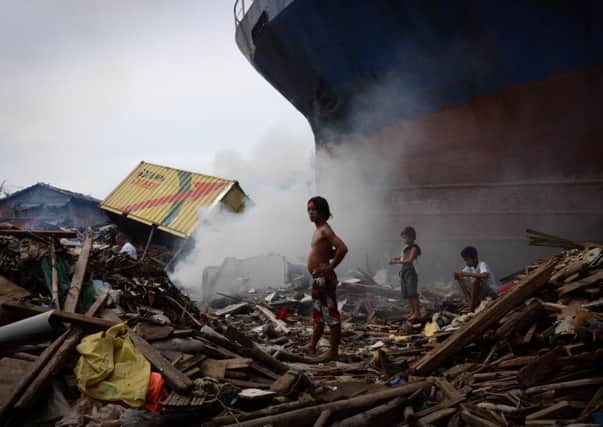Typhoon Haiyan’s victims help themselves too


Weeks after one of the worst storms in history cut a swath of destruction through the Philippines, the road to recovery stretches a long way into the future.
When Typhoon Haiyan battered its way across the islands of the Philippines, it left a trail of utter devastation which will take the country and its people many years to recover from. More than 5,630 people died and an estimated 1,759 are still missing. Around 3.8 million people still have no homes in 57 cities and over 12,000 villages.
Advertisement
Hide AdAdvertisement
Hide AdThe bewildering pictures of destruction, with survivors left hungry, thirsty, traumatised and homeless, provoked a huge outpouring of generosity here at home. Donations of over £850,000 to SCIAF alone have supported our immediate emergency response of getting food, water, clothes and shelter to those in need.
SCIAF and the people we work with in the Philippines are extremely grateful for this extraordinary response. However, the need for ongoing support will be essential in helping communities as they rebuild their homes, and their lives.
The seeds of recovery are starting to become visible in some places. Farmers are already repairing their rice fields. However, whilst the rice fields can be restored quite quickly, it will take years for the palm trees and coconut palms to be productive again.
Commerce, in the form of roadside stalls selling food and other essentials, is also getting under way.
In major population centres hit by the typhoon such as Tacloban on the island of Leyte, people are coming together to clear the rubble and rebuild.
Remote parts of Philippines struggling
SCIAF is working with its sister agencies in the global network of Catholic international aid agencies, Caritas Internationalis. Catholic Relief Services (CRS) and Caritas Philippines have been on the ground from the start, providing aid, and reaching out to people in the more remote areas. An estimated 500,000 people have received assistance from Caritas.
However, many of the more remote parts of the Philippines are still struggling. Father Mark Granflor, director of the local Caritas office in the archdiocese of Capiz, on the island of Paney, has warned of the need for aid to reach all areas.
“It’s true that Tacloban and the island of Leyte were devastated, but other islands including Panay mustn’t be forgotten,” he told us. “Here too, families have been very badly hit. More than 147,000 people have been affected, and you only have to look around to see that people need help.”
Advertisement
Hide AdAdvertisement
Hide AdCaritas staff have travelled to the most remote areas to carry out assessments of the storm damage and the needs of the population.
Teams of volunteers rapidly prepare bags of food items and clothing which are then loaded onto trucks and sent out for distribution.
Positive disposition of Filipino people
In recent weeks 13,000 plastic sheets have been distributed in Panay, in addition to thousands more that have already been distributed on the island of Leyte. The communities themselves are working extremely hard to support each other and the positive disposition of the Filipino people is helping them to cope with the extreme hardship they are having to endure.
Myrna, a mother of four children, who spoke to one Caritas aid worker recently, said: “We’re still lacking everything, and we haven’t received any aid from the government. But in our community we help each other out as much as we can. When one of us has a little food, we share what’s left over with neighbouring families. So we do what can. All the aid you can bring us is welcome.”
Caritas’ Father Granflor has also spoken to us of the incredible positivity of the people in the face of disaster. “These people may have lost their homes and their clothes, but they haven’t lost their dignity. Nothing seems to dampen their spirits.
“Yesterday I met a fisherman and when I asked him if he needed anything he said no and that everything was fine. Sure, he’d lost his home and his boat, but a more fortunate neighbour lent him his own boat when he’d finished fishing. So he was able to go fishing and bring back some fish for his family to eat, sell a little and start getting back on his feet.”
The huge international aid effort now in full swing is making a real difference. With the support of the Scottish public, SCIAF will continue to work in partnership with those in need.
But ultimately, it is the people of the Philippines who need to rebuild their lives and society after the storm.
• Rob Angove is SCIAF’s international programme manager www.sciaf.org.uk
SEE ALSO